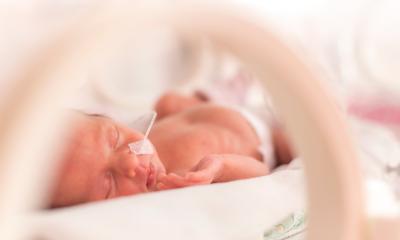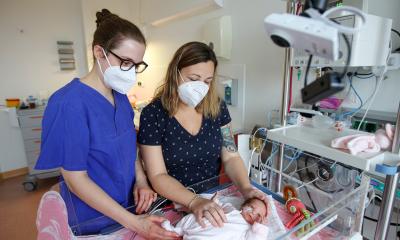Childbirth injury statistics
In 2006, 4.3 million children were born in US hospitals; of these, 158,000 mothers and infants (3.5%) sustained injuries that could have been avoided. For comparison purposes, newly published US statistics could prove interesting for European hospital administrators, says Dot M McSherry of i.t. Communications
In June 2009, the US Agency for Healthcare Research and Quality issued a report on potentially avoidable injuries that occurred during childbirth in 2006. Although this statistic shows a 20% improvement between 2000 and 2006, it is a sobering reminder that quality control programmes must be vigilantly maintained in hospital maternity departments. The highest rates of obstetrical traumas for mothers were caused by instruments during vaginal births. For every 1,000 deliveries in which instruments of any kind were used to assist birth, 160.5 women were injured. The risk of a mother aged 25-34 was highest at 193 per 1,000. Women who had vaginal births without the use of any instrumentation were not exempt from injury: 36.2 were injured for every 1,000 such births. Women at highest risk were young girls aged 15 to 17 (4.8%). Injury during a caesarean delivery was very low, with mothers aged 35-54 at the highest risk (less than half of 1%).
For all delivery types, the rates of obstetrical trauma for mothers were highest among women living in the USA’s wealthiest communities, as well as women with private insurance. These women suffered 44% more injuries during vaginal delivery than women having their delivery in public and community hospitals in poor communities. Women at the official US poverty level who qualified for Medicaid, the federally funded healthcare programme had an injury rate of 127 injuries per 1,000 births compared with other women at 185 injuries.
This trend was also true for women who had caesarean deliveries. Obstetrical trauma rates during caesarean delivery were 35% higher in the wealthiest communities compared with the poorest communities.
Rates of obstetrical trauma also differed by race. Asian-American mothers had the highest rate of childbirth-related injuries associated with vaginal delivery with instruments: 203 injuries per 1,000 births. African-American women had the lowest rate: 108 injuries, and Hispanic and white women were in the middle: 130 and 162 respectively.
Injuries to newborn infants occurred most often at rural hospitals, with two injuries per 1,000 births, followed by 1.5 injuries for infants born in large metropolitan areas. From an infant’s perspective, being born in western states was safer by 0.6% than in north-east states, at 1.4 injuries and 2.0 injuries per 1,000 births respectively.
Caucasian infants had higher injury rates at 1.9 per 1,000 births than did infants of minorities, at 1.4 to 1.5 injuries per 1,000.
The data comprising this report were collected from a sample of academic, urban and community hospitals from 1,900 hospitals located in 25 states. This sample is designed to represent approximately 40% of all hospitals representing all regions of the United States, all bed sizes, ownership (private, public, not-for-profit, religious and for profit).
The US Agency for Healthcare Research and Quality did not offer any explanation of reasons for the surprising disparity of care among different groups. It is a common belief in the US that hospitals located in the wealthiest communities offer
the highest standard of medical care. Obviously in 2006, this was not the case.
Caesarean deliveries are increasing, but so are risks to infants
The number of children born by caesarean delivery is steadily increasing worldwide. Hospitals in Europe, East Asia and South America report rates of 30-40% of all births. In the USA, caesarean deliveries represented 31.1% of all births in 2006, the year for which the most recent statistics are available. This represents an increase of more than 50% since 1996. The proportion of caesarean births compared to vaginal births is expected to continue to escalate because many women deliver all subsequent infants by caesarean after their first procedure.
About 50% of all caesarean deliveries are believed to be elective, performed before labour begins. Physicians and expectant mothers, particularly in industrialised countries, consider childbirth by caesarean delivery to be a safe, low risk procedure for mother and child, time efficient, and relatively inconvenience free.
The risks to the newborn tend to be de-emphasised by medical professionals. Many women are not aware that infants delivered by a planned vaginal birth have fewer complications. While this is to be expected when compared to infants delivered by emergency caesarean, it is not the case expected of infants delivered by elective caesarean sections.
Two recent studies analysing births at two academic hospitals (in Switzerland and the US) provide sobering statistics. Not only does an elective caesarean delivery add a higher level of risk and death to an infant, but at a time of economic depression, these infants add unnecessary cost to healthcare, whether paid by federal healthcare programmes, insurance providers, or the families.
Paediatric and neonatology specialists at the Hôpitaux Universitaires de Geneve evaluated 20 years of data on outcomes of newborns delivered between January 1982 and September 2004 at a gestational age of 34 or more weeks. The study included 56,549 infants, of whom 7,427 (13.3%) were delivered by caesarean section. Of the caesarean deliveries, 34.7% were delivered with elective surgery.
The percentage of caesarean births at the Hôpitaux Universitaires de Genève was quite conservative, based on the statistical average of 29.2% caesarean births in Swiss hospitals in 2004. Yet, at the Hôpitaux Universitaires de Genève, the number of elective caesarean deliveries had doubled from almost 5% of total hospital births in 1982 to almost 10% by the end of 2003. Emergency caesarean deliveries also rose, from 7% in 1982 to 13% in 2003.
Dr Roberta De Luca and her colleagues in the hospital’s paediatrics and obstetrics and gynaecology departments compared the outcomes of infants born vaginally and caesarean delivered infants. Based on their research, they do not recommend that elective caesarean deliveries be performed until the foetus reaches full term. They also strongly recommend that healthcare policy makers and medical professionals become more proactive about monitoring the healthcare and social outcomes of caesarean-delivered infants, and better educate prospective parents of the risks their new baby faces with a caesarean delivery.
The researchers discovered that twice as many of the elective caesarean delivered preterm and full-term infants required hospital admission (14.7% compared to 6.7%). 46% of late preterm (37 gestation weeks or less) caesarean-delivered infants required admission, whereas only 25% of the preterm infants born vaginally did. The researchers did not include the percentage of infants who needed to be admitted to the neonatal ICU instead of the nursery, the treatment they received, or the average number of additional days of hospitalisation before discharge. Nor did they calculate the length of in-patient hospitalisation of mothers who had a natural delivery compared to mothers who had surgery.
Although the risk of developing respiratory problems was very low, 5.5% of the elective caesarean delivered infants developed respiratory morbidity compared to 2.1% of vaginally delivered infants. The difference was more pronounced for the late-preterm group, with 18.9% of the elective caesarean infants having respiratory problems compared to 11.9% of the vaginal birth group.
The lowest, but most disturbing statistic was that elective caesarean infants have three times the risk of death than vaginally delivered infants. While 76 infants, or 0.14% of those born vaginally, died, 14 infants, or 0.54% delivered with elective caesarean surgery died. This rate was nearly comparable to the 0.58% death rate of infants delivered through emergency caesarean surgery.
Faculty specialists in paediatric neonatology, obstetrics and gynaecology, and public health at the University of Colorado School of Medicine conducted a cost analysis. The University of Colorado Hospital and its affiliated Children’s Hospital are regional specialty centres serving not only patients living in Colorado but also in portions of rural Nebraska, New Mexico, Utah and Wyoming.
From its perinatal database, the researchers identified 672 pregnant women who had had a prior caesarean delivery, and had a baby born without congenital abnormalities at the University of Colorado Hospital between October 2005 and June 2008. Of this group, 51% planned an elective repeat caesarean delivery and 49% planned a vaginal birth. Infant outcomes during and subsequent to delivery were evaluated as a factor of cost.
Dr Beena D Kamath and colleagues reviewed the medical records and invoices for the women, adjusting charges to 2008 levels and assigning a uniform payment rate for each medical service provided. The hospital charges, not including the delivery-related physician fees, averaged $6,000 for women who had caesarean delivery and $4,345 for women who had a successful vaginal delivery. The hospital charges, which did not include any physician fees for professional services such as delivery and anaesthesiology, averaged $2,100 for caesarean delivered infants and $1,453 for infants delivered vaginally.
A significantly greater number of infants born by elective caesarean delivery required blow-by oxygen and continuous positive airway pressure in the delivery room, ongoing oxygen supplementation once admitted to the NICU and higher rates of admission for hypoglycaemia. They also required higher rates of oxygen supplementation and ventilation support both in delivery and in the NICU.
The average hospital stay was four days for women and infants in the caesarean delivery group and three days for women who had successful vaginal delivery. Hospital costs were higher for the group of women who planned a vaginal delivery but ultimately required an emergency caesarean, averaging $7,290. This group represented 12.6% of the total, or one-quarter of the women who had planned a natural birth.
The researchers recommend that obstetricians better educate women considering a first elective caesarean delivery about the risks infants face, as well as the fact that not only their first child, but their future deliveries may potentially be caesarean.
The two studies were published in Paediatrics (June 6, 2009, Vol. 123, No. 6, p. 31064-e1071) and Obstetrics & Gynaecology (June 2009, Vol. 113, No. 6, 1248-1258)
01.09.2009








